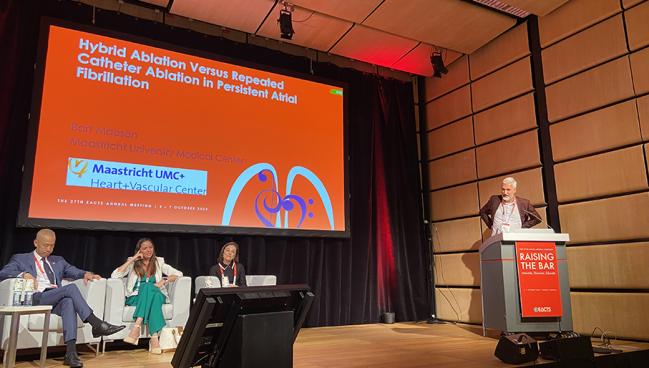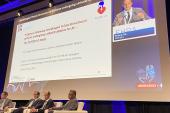Combined Surgical and Catheter Ablation Best for Persistent AF
HARTCAP-AF and CEASE-AF both used epicardial thoracoscopic and endocardial catheter ablation for persistent AF.

VIENNA, Austria—For patients with persistent atrial fibrillation (AF), a hybrid approach that combines a minimally invasive surgical ablation with catheter-based radiofrequency ablation—performed either as a single or staged procedure—was better at reducing the recurrence of atrial tachyarrhythmias when compared with catheter ablation alone, according to the results of two studies.
Last week at the European Association for Cardio-Thoracic Surgery (EACTS) annual meeting, Bart Maesen, MD, PhD (Maastricht University Medical Center, the Netherlands), who led the HARTCAP-AF trial, reported that arrhythmia-free survival without use of antiarrhythmic medication was superior following the hybrid epicardial thoracoscopic and endocardial ablation strategy than it was after catheter ablation alone and was not associated with a higher risk of complications.
Similarly, Piotr Suwalski, MD, PhD (National Institute of the Ministry of Interior and Administration, Warsaw, Poland), senior investigator of CEASE-AF, a trial that tested the hybrid approach but staged the epicardial and endocardial ablations over several months, reported that the hybrid procedure led to greater freedom from atrial tachyarrhythmias without the use of medication in patients with persistent AF when compared with catheter ablation.
The results, say investigators, suggest the hybrid approach could be a good option for select patients able and willing to tolerate the higher up-front “costs” of the combined procedure to increase the likelihood of a better outcome.
“It’s about patient preference,” Maesen told TCTMD. “I think it’s a little bit arrogant of us doctors to choose instead of the patient. We should inform our patients well so they know what their options are and then the patient should choose. But I have to tell you, since we did HARTCAP-AF, almost every patient with persistent atrial fibrillation is offered the option of the hybrid procedure at our center.”
The results of catheter ablation are very good for paroxysmal AF, but the outcomes are “rather disappointing” for patients with persistent AF, said Maesen.
Similarly, during his late-breaking presentation, Suwalski noted that the effectiveness of catheter ablation in persistent AF patients ranges from 38% to 62% in follow-up ranging from 6 to 15 months. “As atrial fibrillation progresses to persistent and long-standing, persistent forms, endocardial ablation outcomes are limited, regardless of lesion set and energy source,” said Suwalski.
Similar Quality-of-Life Outcomes
In HARTCAP-AF, surgeons first tackled the atrial substrate thoracoscopically from the epicardium, isolating both pulmonary veins with a box lesion, as well as isolating the ligament of Marshall, and finished the procedure with exclusion of the left atrial appendage (LAA). The epicardial procedure was followed by EP voltage mapping and endocardial catheter ablation with radiofrequency energy, if necessary.
“This allows us to touch up conduction gaps in the epicardial lesion sets,” said Maesen. “It also allows us to treat periprocedural arrhythmias and other endocardial lesions depending on the individual’s substrate. . . . It combines the best of two worlds in creating a procedure that can be more individualized.”
HARTCAP-AF included 41 ablation-naïve patients (mean age 63 years; 88% male) with nonparoxysmal AF randomized to hybrid ablation or standard catheter ablation. All patients had persistent AF, with approximately 10% in both treatment arms having long-standing, persistent AF. Of those randomized to the hybrid procedure, eight patients needed the endocardial touch-up ablation.
The primary endpoint—freedom from any atrial tachyarrhythmia of more than 5 minutes while off antiarrhythmic drug therapy—occurred in 89% of patients treated with hybrid ablation and 41% of those undergoing catheter ablation alone (P = 0.02). Freedom from any atrial tachyarrhythmia at 12 months while allowing for antiarrhythmic drug therapy was observed in 95% of patients in the hybrid group and 41% in the catheter ablation arm (P = 0.03).
There were no deaths, strokes, need for new pacemakers, or conversions to sternotomy in both treatment arms, with comparable and low rates of complications. There was a single major adverse event in each treatment group: one patient treated with catheter ablation had a femoral artery bleed, while there was one case of pericarditis/pericardiocentesis with hybrid ablation. In the hands of experienced surgeons, said Maesen, these data suggest it is not associated with any safety concerns. Quality of life was similar with the two treatments.
“I was very happy with that [quality-of-life] result because the hybrid procedure is a surgical procedure,” said Maesen. “We call it a minimally invasive procedure, but the patients really do have to recover for 4 to 6 months before they are up and running again. So, to see no difference at 12 months between the [two approaches] was comforting.”
While the HARTCAP-AF investigators performed the hybrid ablation during a single procedure, it can also be staged, just as it was in the CEASE-AF trial. In that study, the index procedure was thoracoscopic epicardial ablation performed by the surgeon—isolation of the pulmonary veins and left posterior atrial wall, as well as LAA exclusion—followed by endocardial catheter ablation 91 to 180 days after the surgery.
CEASE-AF included 154 ablation-naïve patients (mean age 61 years; 75% male) with a history of symptomatic persistent AF and a left atrial diameter > 4.0 cm or symptomatic long-standing, persistent AF. The primary endpoint—freedom from AF/atrial flutter/atrial tachycardia of more than 30 seconds at 12 months while off antiarrhythmic drug therapy—was 71.6% with hybrid ablation and 39.2% in the catheter ablation arm (P < 0.001). Major complication rates through 30 days after the index procedure plus 30 days after the staged catheter ablation were similar with both procedures.
Typical Patients
To TCTMD, Maesen said patients typically referred for the hybrid procedure are endurance athletes who may have developed AF after a lifetime of activity.
“They’ll often say, ‘I want this one procedure and then I want to do my cardiac rehabilitation, and then after that I want to go out and do my thing without getting atrial fibrillation,’” he said. “Some patients also just have had enough of medications, and they might have heard about their friend having catheter ablation, but they choose to undergo this one ‘heavy’ procedure to be free from atrial fibrillation for a longer time.”
When it comes to timing of the epicardial ablation, there are pros and cons to both the staged and single hybrid procedure. In doing everything in one shot, the surgeon and electrophysiologist (EP) can closely work together to identify arrhythmogenic lesions while the patient benefits by a single hospital visit. The downside is that it’s logistically demanding, which is why some centers do it in a staged manner. On the other hand, a staged procedure allows the endocardial lesions time to develop and may give a more-accurate assessment of what part of the atrium still needs to be touched up by the EP.
“I think, in general, if you do it one or two stages, it's not that important,” said Maesen. “Even if you do it both ways, you will still have the big advantage over doing thoracoscopic ablation or catheter ablation alone.”
Michael O’Riordan is the Managing Editor for TCTMD. He completed his undergraduate degrees at Queen’s University in Kingston, ON, and…
Read Full BioSources
Maesen B, et al. Hybrid ablation versus repeated catheter ablation in persistent atrial fibrillation. Presented at: EACTS 2023. October 6, 2023. Vienna, Austria.
Suwalski P, on behalf of the CEASE-AF investigators. Effectiveness and safety of hybrid epicardial and endocardial ablation in patients with persistent and longstanding persistent atrial fibrillation. Presented at: EACTS 2023. October 6, 2023. Vienna, Austria.
Disclosures
- Maesen reports consulting for AtriCure and Medtronic.
- Suwalski reports consulting for AtriCure and Medtronic and receiving honoraria from Edwards.





Comments